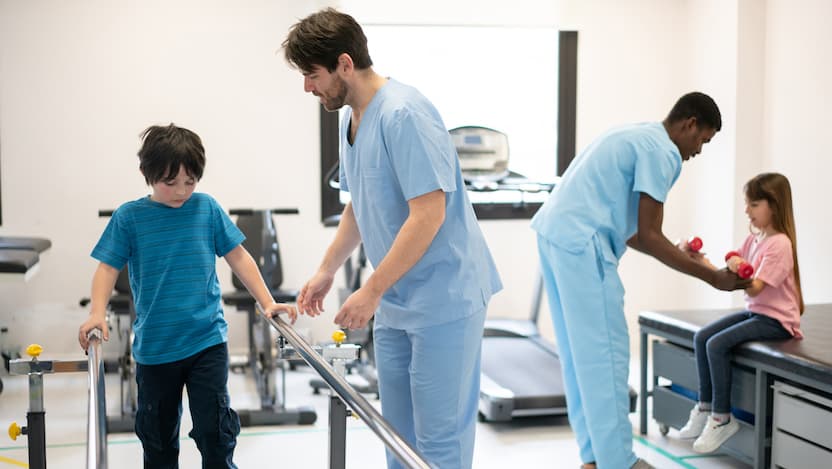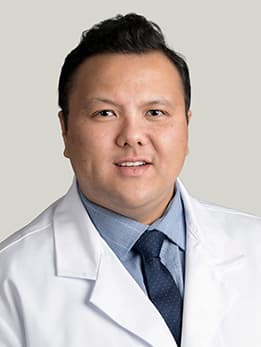Physicians issue warning about rare neurological condition, expected to appear this fall

Each fall, as kids go back to school and share germs with their peers and the changing seasons create environmental conditions perfect for viral growth, symptoms matching the cold and flu proliferate in classrooms and day care centers like clockwork. Sometimes these symptoms are severe enough to land patients in the emergency room. That’s where physicians started to notice a troubling trend six years ago.
“A few days after presenting with symptoms like cough, congestion, and worsening asthma, these little kids will suddenly have rapid onset paralysis in one or more of their limbs, resembling polio,” said pediatric neurologist Henry David, MD, the Director of Neurocritical Care at the University of Chicago Medicine Comer Children’s Hospital. “Usually, this paralysis is permanent to a large degree.”
Known as acute flaccid myelitis, or AFM, this rapid onset paralysis following a viral illness is a bit of a medical mystery to physicians, with a number of quirky traits that distinguish it from other post-viral conditions. For one thing, its causes aren’t entirely clear — though physicians agree that a viral infection is likely what triggers the condition. For another, nearly all of the patients affected are very young children, between the ages of 3 and 6, who have experienced a viral illness within the last month. Many (though not all) have a history of asthma, and many (though not all) report joint, neck, and back pain shortly before the onset of paralysis.
Perhaps strangest of all, the disease appears to follow a two-year outbreak cycle, with a rash of patients appearing every other fall. While the condition is extremely rare, affecting only a handful of children in the state of Illinois each season, its effects can be severe, causing permanent paralysis and in severe cases, respiratory failure and even death.
With an outbreak due this year and so many mysteries surrounding the condition, pediatricians are worried about what this illness means for their patients — especially with potential complicating factor of the ongoing COVID-19 pandemic.
“We’ve been tracking this illness for about six years, but realistically, this or something like it has existed for three or four decades,” said David. “It seems to be an infectious and possibly immunological phenomenon, where the body’s own inflammatory response to a virus contributes to the grey matter injury of the spinal cord, damaging the patient’s motor neurons, which control movement. Once damaged, these neurons can’t regenerate, and leaves the patient with weakened or paralyzed limbs.”
Analysis of patient samples have found a connection between AFM and common enteroviruses, in particular Enterovirus D68, which typically leads to flu-like symptoms including fever, cough, congestion, vomiting, and/or diarrhea. But, as pediatric infectious disease expert Madan Kumar, DO, the Director of the Pediatric Antimicrobial Stewardship Service at Comer Children’s Hospital points out, “Patients who are diagnosed with AFM don’t always test positive for a virus, and about one in ten patients is completely asymptomatic for a viral illness. Diagnosis is very challenging, and we think that we may be underappreciating the number of cases.”
AFM is so rare that no specific targeted treatment exists for the disease; available treatments focus on reducing the inflammatory immune response. “When we see kids with limb weakness, we’ll throw immunomodulatory therapy, plasmapheresis — everything we’ve got at them,” said David. “The problem is, it’s not clear how much these treatments help, because often we catch the condition so late, and because there haven’t been enough cases to do a proper randomized clinical trial.”
Once the initial illness passes, patients may receive physical therapy to aid their recovery, or seek out specialized centers that offer nerve grafting to restore some control and sensation in the paralyzed limbs.
“Only an exceedingly small number of patients with enteroviruses end up with this condition, and it’s not clear what combination of host and viral factors trigger it,” Kumar said. “The thing with diseases that are this rare is that many parents and physicians have less awareness of the condition so they don’t recognize the signs, and we miss the opportunity to provide early therapy for these kids.”
This year’s predicted outbreak is especially worrisome for pediatricians because it’s still unclear how living in the era of COVID-19 will impact detection, diagnosis, and treatment of AFM. “Given our move toward social distancing and people spending most of their time at home, we’ve interrupted the epidemiology of these viruses,” said Kumar. “This has probably delayed the onset of this year’s outbreak. But we know that children are a major driver in the spread of respiratory illnesses, and as kids are going back to school and businesses are reopening, it’s just a matter of time before these traditional seasonal viruses pick up again.”
The lack of clarity in what triggers AFM also makes it uncertain whether contracting COVID-19 this fall might put kids at greater risk for the condition. It is unclear if contracting multiple respiratory viruses — such as an enterovirus and a rhinovirus — at the same time changes the pathophysiology of AFM. And while many children who contract COVID-19 remain asymptomatic, it’s unknown whether this might cause complications if they contract other respiratory illnesses.
The concerns go beyond the risk of a COVID-19 infection. “We’re concerned that this pandemic means that there will be less hands-on interaction between kids and many of their caregivers,” David said. “Parents might not notice the signs, and may be hesitant to take their children to the hospital because of fears about contracting COVID-19. People have the tendency to develop tunnel vision, and while we’re all so fixated on COVID-19, there’s a risk of letting our guard down about other diseases.”
The physicians stress that families should take all of the normal precautions to prevent viral respiratory illnesses this year, in addition to COVID-19 precautions, such as masking, social distancing and good hand hygiene. In particular, Kumar said, “Get a flu vaccine. We don’t know how COVID-19 will interact with other viruses. Minimize your chances — if ever there was a year to be sure to get your flu vaccine, this is it.”
One small silver lining to the pandemic is the increasing availability of telemedicine appointments, making it easier for patients to connect with specialists, like those at Comer Children’s Hospital, a center of excellence for managing AFM patients and a referral center for suspected cases. “I often see children with AFM who had previously been to an emergency room or urgent care with early signs of weakness or partial paralysis,” said David. “But most providers have never seen this disease, so how would they know to look for it? It’s under-reported and underdiagnosed. If we can get the word out and tell people to watch for the early signs, it might make a difference.”
While it’s not yet clear what this season’s predicted AFM outbreak will look like, the physicians hope that with time, a greater understanding of the condition can lead to better treatments and improved outcomes. “My goal is to catch more of these patients earlier in the disease course, and to share what we learn from treating them with our colleagues who are also working on this challenge,” said David. “We’re all working to make a difference for these children.”

Henry David, MD
Henry David, MD, is a pediatric neurologist who specializes in neurocritical care and treats children of all ages with serious neurological conditions who require acute care to long-term treatment. He also is an expert in cerebrovascular disorders, including ischemic stokes and hemorrhagic strokes, and provides comprehensive, compassionate care to patients and their families.
Learn more about Dr. David
Madan Kumar, DO
Madan Kumar, DO, specializes in pediatric infectious diseases. Dr. Kumar is part of a collaborative, interdisciplinary service targets improving drug selection, slowing the emergence of antimicrobial resistance, reducing antibiotic expenditures, and improving patient outcomes at UChicago Medicine’s Comer Children’s Hospital.
Learn more about Dr. Kumar
Pediatric Neurology and Neurosurgery
Our pediatric neurologists and neurosurgeons work closely together to coordinate effective, comprehensive and innovative treatment plans for children with neurological illnesses. As leaders in pediatric neuroscience research, we optimize care for the entire spectrum of pediatric neurological disease.
Learn more about pediatric neurology